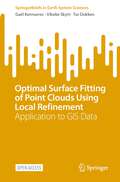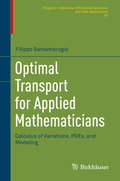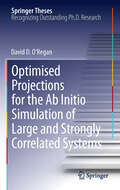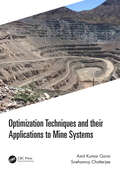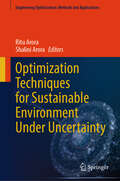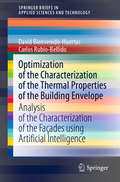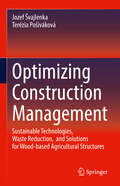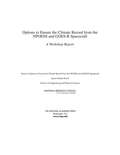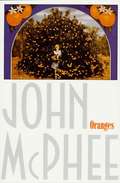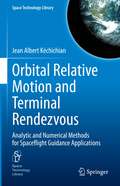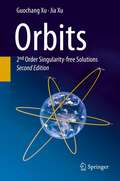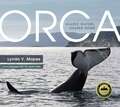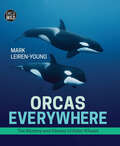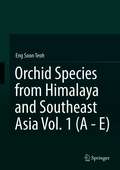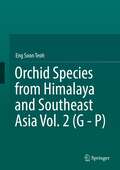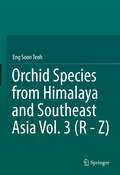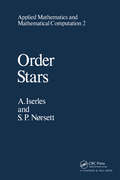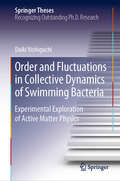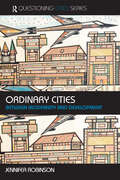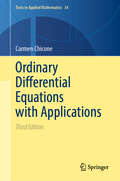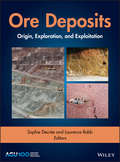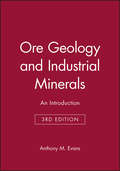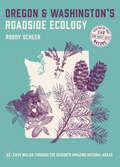- Table View
- List View
Optimal Surface Fitting of Point Clouds Using Local Refinement: Application to GIS Data (SpringerBriefs in Earth System Sciences)
by Tor Dokken Gaël Kermarrec Vibeke SkyttThis open access book provides insights into the novel Locally Refined B-spline (LR B-spline) surface format, which is suited for representing terrain and seabed data in a compact way. It provides an alternative to the well know raster and triangulated surface representations. An LR B-spline surface has an overall smooth behavior and allows the modeling of local details with only a limited growth in data volume. In regions where many data points belong to the same smooth area, LR B-splines allow a very lean representation of the shape by locally adapting the resolution of the spline space to the size and local shape variations of the region. The iterative method can be modified to improve the accuracy in particular domains of a point cloud. The use of statistical information criterion can help determining the optimal threshold, the number of iterations to perform as well as some parameters of the underlying mathematical functions (degree of the splines, parameter representation). The resulting surfaces are well suited for analysis and computing secondary information such as contour curves and minimum and maximum points. Also deformation analysis are potential applications of fitting point clouds with LR B-splines.
Optimal Transport for Applied Mathematicians
by Filippo SantambrogioThis monograph presents a rigorous mathematical introduction to optimal transport as a variational problem, its use in modeling various phenomena, and its connections with partial differential equations. Its main goal is to provide the reader with the techniques necessary to understand the current research in optimal transport and the tools which are most useful for its applications. Full proofs are used to illustrate mathematical concepts and each chapter includes a section that discusses applications of optimal transport to various areas, such as economics, finance, potential games, image processing and fluid dynamics. Several topics are covered that have never been previously in books on this subject, such as the Knothe transport, the properties of functionals on measures, the Dacorogna-Moser flow, the formulation through minimal flows with prescribed divergence formulation, the case of the supremal cost, and the most classical numerical methods. Graduate students and researchers in both pure and applied mathematics interested in the problems and applications of optimal transport will find this to be an invaluable resource.
Optimised Projections for the Ab Initio Simulation of Large and Strongly Correlated Systems
by David D. O'ReganDensity functional theory (DFT) has become the standard workhorse for quantum mechanical simulations as it offers a good compromise between accuracy and computational cost. However, there are many important systems for which DFT performs very poorly, most notably strongly-correlated materials, resulting in a significant recent growth in interest in 'beyond DFT' methods. The widely used DFT+U technique, in particular, involves the addition of explicit Coulomb repulsion terms to reproduce the physics of spatially-localised electronic subspaces. The magnitude of these corrective terms, measured by the famous Hubbard U parameter, has received much attention but less so for the projections used to delineate these subspaces. The dependence on the choice of these projections is studied in detail here and a method to overcome this ambiguity in DFT+U, by self-consistently determining the projections, is introduced. The author shows how nonorthogonal representations for electronic states may be used to construct these projections and, furthermore, how DFT+U may be implemented with a linearly increasing cost with respect to system size. The use of nonorthogonal functions in the context of electronic structure calculations is extensively discussed and clarified, with new interpretations and results, and, on this topic, this work may serve as a reference for future workers in the field.
Optimization Techniques and their Applications to Mine Systems
by Amit Kumar Gorai Snehamoy ChatterjeeThis book describes the fundamental and theoretical concepts of optimization algorithms in a systematic manner, along with their potential applications and implementation strategies in mining engineering. It explains basics of systems engineering, linear programming, and integer linear programming, transportation and assignment algorithms, network analysis, dynamic programming, queuing theory and their applications to mine systems. Reliability analysis of mine systems, inventory management in mines, and applications of non-linear optimization in mines are discussed as well. All the optimization algorithms are explained with suitable examples and numerical problems in each of the chapters. Features include:• Integrates operations research, reliability, and novel computerized technologies in single volume, with a modern vision of continuous improvement of mining systems.• Systematically reviews optimization methods and algorithms applied to mining systems including reliability analysis.• Gives out software-based solutions such as MATLAB®, AMPL, LINDO for the optimization problems.• All discussed algorithms are supported by examples in each chapter.• Includes case studies for performance improvement of the mine systems. This book is aimed primarily at professionals, graduate students, and researchers in mining engineering.
Optimization Techniques for Sustainable Environment Under Uncertainty (Engineering Optimization: Methods and Applications)
by Ritu Arora Shalini AroraThe book's objective is to develop mathematical structures that can be applied to real-life problems with sustainable goals. It focuses on the impact of sustainable living on social, economic, and environmental aspects, aiming to create optimization techniques that minimize emissions and maximize green energy. These optimization problems may include sustainable transport, cities, economic development, living, and tourism. The book brings together researchers, academics, and professionals from various fields to find optimal or satisfactory solutions for various environmentally friendly sustainable problems. It aims to achieve this not only with existing optimization techniques, but also with novel approaches such as lexicographic optimization, heuristic approaches, DEA, and genetic algorithms. The goal is to develop practical algorithms and methods applicable to these problems under uncertain circumstances and explore the potential for improving the efficiency of existing algorithms.
Optimization of the Characterization of the Thermal Properties of the Building Envelope: Analysis of the Characterization of the Façades using Artificial Intelligence (SpringerBriefs in Applied Sciences and Technology)
by Carlos Rubio-Bellido David Bienvenido-HuertasThis book is about the optimization of the characterization of the thermal properties of building envelopes, through experimental tests and the use of artificial intelligence. It analyses periodic and stationary thermal properties using measurement approaches based on the heat flow meter method and the thermometric method. These measurements are then analysed using advanced artificial intelligence algorithms.The book is structured in four parts, beginning with a discussion of the importance of thermal properties in the energy performance of buildings. Secondly, theoretical and experimental methods for characterizing thermal properties are analysed. Then, the methodology is developed, and the characteristics and properties of the algorithms used are explored. Finally, the results obtained with the algorithms are analysed and the most appropriate approaches are determined.This book is of interest to researchers, civil and industrial engineers, energy auditors and architects, by providing a resource which improves energy audit tasks in existing buildings.
Optimizing Construction Management: Sustainable Technologies, Waste Reduction, and Solutions for Wood-based Agricultural Structures
by Jozef Švajlenka Terézia PošivákováThis book examines the persistent global problem of low productivity of systems in the construction industry and how it mobilizes research and social efforts to find more efficient procedures and processes associated with production, construction, and operation. The authors discuss increasing the efficiency of construction sites and off-site technologies that present particularly challenging problems in the areas of implementation of lean principles in production procedures, reduction of waste, and improvement of quality and predictability of construction projects. Finally, the book considers the innovation potential for ecological and sustainable construction technologies based on wood and the use of digital tools. It further explores the innovation potential for transforming traditional structural solutions of agricultural buildings using modern, efficient, sustainable, and ecologically sound construction technologies based on wood.
Options to Ensure the Climate Record from the NPOESS and GOES-R Spacecraft: A Workshop Report
by National Research Council of the National AcademiesIn 2000, the nation’s next-generation National Polar-orbiting Operational Environmental Satellite System (NPOESS) program anticipated purchasing six satellites for $6.5 billion, with a first launch in 2008. By November 2005, however, it became apparent that NPOESS would overrun its cost estimates by at least 25 percent. In June 2006, the planned acquisition of six spacecraft was reduced to four, the launch of the first spacecraft was delayed until 2013, and several sensors were canceled or descoped in capability. To examine the impacts of these changes, particularly those associated with climate research, and ways to mitigate those impacts, NASA and NOAA asked the NRC to add this task to its ongoing "decadal survey," Earth Science and Applications from Space. The sponsors and the NRC agreed to address this task separately and to base its analysis on a major workshop. This book presents summaries of discussions at the workshop, which included sessions on the measurements and sensors originally planned for NPOESS and GOES-R; generation of climate data records; mitigation options, including the role of international partners; and cross-cutting issues.
Oranges
by John McpheeA classic of reportage, Oranges was first conceived as a short magazine article about oranges and orange juice, but the author kept encountering so much irresistible information that he eventually found that he had in fact written a book. It contains sketches of orange growers, orange botanists, orange pickers, orange packers, early settlers on Florida’s Indian River, the first orange barons, modern concentrate makers, and a fascinating profile of Ben Hill Griffin of Frostproof, Florida who may be the last of the individual orange barons. McPhee’s astonishing book has an almost narrative progression, is immensely readable, and is frequently amusing. Louis XIV hung tapestries of oranges in the halls of Versailles, because oranges and orange trees were the symbols of his nature and his reign. This book, in a sense, is a tapestry of oranges, too--with elements in it that range from the great orangeries of European monarchs to a custom of people in the modern Caribbean who split oranges and clean floors with them, one half in each hand.
Orbital Relative Motion and Terminal Rendezvous: Analytic and Numerical Methods for Spaceflight Guidance Applications (Space Technology Library #39)
by Jean Albert KéchichianThis book provides a comprehensive analysis of time-fixed terminal rendezvous around the Earth using chemical propulsion.The book has two main objectives. The first is to derive the mathematics of relative motion in near-circular orbit when subjected to perturbations emanating from the oblateness of the Earth, third-body gravity, and atmospheric drag. The mathematics are suitable for quick trajectory prediction and the creation of computer codes and efficient software to solve impulsive maneuvers and fly rendezvous missions.The second objective of this book is to show how the relative motion theory is applied to the exact precision-integrated, long-duration, time-fixed terminal rendezvous problem around the oblate Earth for the general elliptic orbit case.The contents are both theoretical and applied, with long-lasting value for aerospace engineers, trajectory designers, professors of orbital mechanics, and students at the graduate level and above.
Orbits
by Guochang Xu Jia XuThe development of the orbits theory lags behind the development of satellite technology. This book provides, for the first time in the history of human satellite development, the complete third order solution of the orbits under all possible disturbances. It describes the theory of satellite orbits, derives the complete solutions of the orbital disturbances, describes the algorithms of orbits determination based on the theory, describes the applications of the theory to the phenomenon of the satellite formation physically. The subjects include: Orbits Motion Equations, Disturbance theory, Solutions of the differential Equations, Algorithms of Orbits determinations, Applications of the theory to the satellite formation.
Orca: Shared Waters, Shared Home
by Lynda MapesOrca whale J35, also known as "Tahlequah," gave birth in July of 2018 in the waters off British Columbia, but her calf died soon after, leading its mother to carry her for 17 days across 1000 miles before finally releasing the calf and rejoining her pod. This extraordinary and caring behavior sparked not only worldwide sympathy, but also a revival of our awareness of the critical need to preserve orcas, the chinook salmon they feed on, and their habitat that together make up the core of Pacific Northwest identity. In Orca: Shared Waters, Shared Home journalist Lynda V. Mapes explores the natural history of the orca and the unique challenges for survival of the Southern Resident group that frequents Puget Sound. These whales are among the most urban in the world, a focus of researchers, tourists, and politicians alike. Once referred to as "blackfish" and still known as "killer whales," orcas were for generations regarded as vermin to be avoided or exterminated, then later were captured live for aquariums all over the world. With greater exposure, scientists realized how intelligent the mammal is and are learning about their matriarchal family groups, vocalizations, behavior, and different subspecies. Today only 74 Southern Resident whales are left, and they are threatened by habitat degradation, lack of chinook salmon (their primary food source), relentless growth, and climate change. Can we reverse the trend? This special project, co-published with the Pulitzer Prize winning Seattle Times newspaper, features stunning imagery by Times photographer Steve Ringman, as well as from partner organizations including The Whale Museum, NOAA, and Center for Whale Research.
Orcas Everywhere: The History and Mystery of Killer Whales (Orca Wild #1)
by Mark Leiren-YoungOrcas are found in every ocean on the planet. But can they survive their relationship with humans? Orcas Everywhere looks at how humans around the world (Indigenous and non-Indigenous alike) related to orcas in the past, how we relate to them now and what we can do to keep cetacean communities alive and thriving. The book deals with science, philosophy, environmentalism and ethics in a kid-friendly and accessible way. Writer, filmmaker and orca activist Mark Leiren-Young takes us back to when killer whales were considered monsters and examines how humans went from using orcas for target practice to nearly loving them to death. If you know a young person who loves Free Willy or Finding Nemo, they will fall in love with these whales.
Orchid Species from Himalaya and Southeast Asia Vol. 1 (A - E)
by Eng Soon TeohA presentation of 491 popular orchid species with 13 varieties and 3 natural hybrids in 51 genera with names beginning with A to E carefully detailed with beautiful photographs and concise descriptions of the plants, their distribution and habitats by a well-known author and photographer. Each genus is assigned a separate chapter. Coverage of the most commonly cultivated Asian species including their varieties and cultivars (e.g. in Bulbophyllum 82 species; Coelogyne 37 species; Dendrobium 210 species) is exhaustive. The orchids are photographed from their best perspective as individual blooms or entire inflorescences. Many species are also shown growing in their natural habitat. Representative hybrids are included to illustrate how some species have contributed to show-worthiness of various genera, their adaptation to a wider climate range, and easy cultivation. This book is a pleasure to view; simultaneously, an easy reference for the identification of orchid species and it provides a guide on how best to grow them. Nowhere else will one find so many popular species beautifully illustrated in a single volume.Volume 1 is the first of a 3 Volume series that will showcase over 900 species plus varieties in 117 genera. A must for everyone fascinated by orchids or simply with a love for nature.
Orchid Species from Himalaya and Southeast Asia Vol. 2 (G - P)
by Eng Soon TeohA presentation of over 700 popular orchid species in 104 genera carefully detailed with beautiful photographs and concise descriptions of plants, their distribution and habitats by a well-known author and photographer. Each genus is assigned a separate chapter. Coverage of the most commonly cultivated Asian species including their varieties and cultivars (e.g. in Bulbophyllum 72 species; Coelogyne 33 species; Dendrobium 161 species; Paphiopedilum 58 species; Phalaenopsis 60 species; Vanda 44 species) is exhaustive. The orchids are photographed from their best perspective, individual blooms and entire inflorescence: additionally, many species are also shown growing in their natural habitat. Representative hybrids are included to illustrate how some species have contributed to show-worthiness of various genera, their adaptation to a wider climate range, and easy cultivation. This book is a pleasure to view; simultaneously, an easy reference for the identification of orchid species and it provides a guide on how best to grow them. Nowhere else will one find so many popular species beautifully illustrated in a single volume.A must for everyone fascinated by orchids or with a love for nature.
Orchid Species from Himalaya and Southeast Asia Vol. 3 (R - Z)
by Eng Soon TeohA presentation of over 700 popular orchid species in 104 genera carefully detailed with beautiful photographs and concise descriptions of plants, their distribution and habitats by a well-known author and photographer. Each genus is assigned a separate chapter. Coverage of the most commonly cultivated Asian species including their varieties and cultivars (e.g. in Bulbophyllum 72 species; Coelogyne 33 species; Dendrobium 161 species; Paphiopedilum 58 species; Phalaenopsis 60 species; Vanda 44 species) is exhaustive. The orchids are photographed from their best perspective, individual blooms and entire inflorescence: additionally, many species are also shown growing in their natural habitat. Representative hybrids are included to illustrate how some species have contributed to show-worthiness of various genera, their adaptation to a wider climate range, and easy cultivation. This book is a pleasure to view; simultaneously, an easy reference for the identification of orchid species and it provides a guide on how best to grow them. Nowhere else will one find so many popular species beautifully illustrated in a single volume.A must for everyone fascinated by orchids or with a love for nature.
Order Out of Chaos
by Ilya Prigogine Isabelle StengersA pioneering book that shows how the two great themes of classic science, order and chaos, are being reconciled in a new and unexpected synthesis.Order Out of Chaos is a sweeping critique of the discordant landscape of modern scientific knowledge. In this landmark book, Nobel Laureate Ilya Prigogine and acclaimed philosopher Isabelle Stengers offer an exciting and accessible account of the philosophical implications of thermodynamics. Prigogine and Stengers bring contradictory philosophies of time and chance into a novel and ambitious synthesis. Since its first publication in France in 1978, this book has sparked debate among physicists, philosophers, literary critics and historians.
Order Stars: Theory and Applications
by A. Iserles S.P. NorsettThis book familiarizes the mathematical community with an analytic tool that is capable of so many applications and presents a list of open problems which might be amenable to analysis with order stars.
Order and Fluctuations in Collective Dynamics of Swimming Bacteria: Experimental Exploration of Active Matter Physics (Springer Theses)
by Daiki NishiguchiThis thesis focuses on experimental studies on collective motion using swimming bacteria as model active-matter systems. It offers comprehensive reviews of state-of-the-art theories and experiments on collective motion from the viewpoint of nonequilibrium statistical physics. The author presents his experimental studies on two major classes of collective motion that had been well studied theoretically. Firstly, swimming filamentous bacteria in a thin fluid layer are shown to exhibit true, long-range orientational order and anomalously strong giant density fluctuations, which are considered universal and landmark signatures of collective motion by many numerical and theoretical works but have never been observed in real systems. Secondly, chaotic bacterial turbulence in a three-dimensional dense suspension without any long-range order as described in the first half is demonstrated to be capable of achieving antiferromagnetic vortex order by imposing a small number of constraints with appropriate periodicity. The experimental results presented significantly advance our fundamental understanding of order and fluctuations in collective motion of motile elements and their future applications.
Ordinary Cities: Between Modernity and Development (Questioning Cities)
by Jennifer RobinsonWith the urbanization of the world's population proceeding apace and the equally rapid urbanization of poverty, urban theory has an urgent challenge to meet if it is to remain relevant to the majority of cities and their populations, many of which are outside the West. This groundbreaking book establishes a new framework for urban development. It makes the argument that all cities are best understood as ‘ordinary’, and crosses the longstanding divide in urban scholarship and urban policy between Western and other cities (especially those labelled ‘Third World’). It considers the two framing axes of urban modernity and development, and argues that if cities are to be imagined in equitable and creative ways, urban theory must overcome these axes with their Western bias and that resources must become at least as cosmopolitan as cities themselves. Tracking paths across previously separate literatures and debates, this innovative book - a postcolonial critique of urban studies - traces the outlines of a cosmopolitan approach to cities, drawing on evidence from Rio, Johannesburg, Lusaka and Kuala Lumpur. Key urban scholars and debates, from Simmel, Benjamin and the Chicago School to Global and World Cities theories are explored, together with anthropological and developmentalist accounts of poorer cities. Offering an alternative approach, Ordinary Cities skilfully brings together theories of urban development for students and researchers of urban studies, geography and development.
Ordinary Differential Equations with Applications (Texts in Applied Mathematics #34)
by Carmen ChiconeThis book, developed during 20 years of the author teaching differential equations courses at his home university, is designed to serve as a text for a graduate level course focused on the central theory of the subject with attention paid to applications and connections to other advanced topics in mathematics. Core theory includes local existence and uniqueness, the phase plane, Poincaré-Bendixson theory, Lyapunov and linearized stability, linear systems, Floquet theory, the Grobman–Hartman theorem, persistence of rest points and periodic orbits, the stable and center manifold theorems, and bifurcation theory. This edition includes expanded treatment of deterministic chaos, perturbation theory for periodic solutions, boundary value problems, optimization, and a wide range of their applications. In addition, it contains a formulation and new proof of a theorem on instability of rest points in the presence of an eigenvalue with positive real part, and new proofs of differential inequalities and Lyapunov’s center theorem. New sections present discussions of global bifurcation, the Crandall–Rabinowitz theorem, and Alekseev’s formula. Of particular note is a new chapter on basic control theory, a discussion of optimal control, and a proof of a useful special case of the maximum principle. A key feature of earlier editions, a wide selection of original exercises, is respected in this edition with the inclusion of a wealth of new exercises. Reviews of the first edition:“As an applied mathematics text on linear and nonlinear equations, the book by Chicone is written with stimulating enthusiasm. It will certainly appeal to many students and researchers.”—F. Verhulst, SIAM Review “The author writes lucidly and in an engaging conversational style. His book is wide-ranging in its subject matter, thorough in its presentation, and written at a generally high level of generality, detail, and rigor.”—D. S. Shafer, Mathematical Reviews
Ore Deposit Geology
by John RidleyMapping closely to how ore deposit geology is now taught, this textbook systematically describes and illustrates the major ore deposit types, linking this to their settings in the crust, and the geological factors behind their formation. Written for advanced undergraduate and graduate students with a basic background in the geosciences, it provides a balance of practical information and coverage of the relevant geological sciences, including petrological, geochemical, hydrological and tectonic processes. Important theory is summarized without unnecessary detail and integrated with students' learning in other topics, including magmatic processes and sedimentary geology, enabling students to make links across the geosciences. Students are supported by further reading, a comprehensive glossary, and problems and review questions that test the application of theoretical approaches and encourage students to use what they have learnt. A website includes visual resources and combines with the book to provide students and instructors with a complete learning package.
Ore Deposits: Origin, Exploration, and Exploitation (Geophysical Monograph Series #242)
by Laurence Robb Sophie DecreeThe latest knowledge on mineral ore genesis and the exploration of ore deposits Global demand for metals has risen considerably over the past decade. Geologists are developing new approaches for studying ore deposits and discovering new sources. Ore Deposits: Origin, Exploration, and Exploitation is a compilation of diverse case studies on new prospects in ore deposit geology including atypical examples of mineral deposits and new methods for ore exploration. Volume highlights include: Presentation of the latest research on a range of ore deposit types Application of ore deposits to multiple areas of geology and geophysical exploration Emphasis on diverse methods and tools for the study of ore deposits Useful case studies for geologists in both academia and industry Ore Deposits: Origin, Exploration, and Exploitation is a valuable resource for economic geologists, mineralogists, petrologists, geochemists, mining engineers, research professionals, and advanced students in relevant areas of academic study.
Ore Geology and Industrial Minerals: An Introduction (Geoscience Texts)
by Anthony M. EvansMuch new data and many new ideas have emerged in the area of ore geology and industrial minerals since publication of the second edition of this text in 1987. The overriding philosophy behind this new edition is the inclusion and integration of this new material within the established framework of the text. The third edition is re-presented in the modern double-column format. Non-metallic deposits of industrial and bulk materials are fully covered to meet the changing emphasis of courses in applied geology. In addition, chapter 1 has been considerably enlarged to include a section on mineral economics covering metals, industrial minerals and bulk materials. In this section, the various aspects of economic exploitation of industrial and bulk materials are compared with those of metallic deposits. Other major revisions and additions include a section on fluid inclusions, expansion of the section on wall rock alteration, expansion of the material on isotope studies, and the inclusion of a section on hydraulic fracturing and seismic pumping.
Oregon and Washington's Roadside Ecology: 33 Easy Walks Through the Region's Amazing Natural Areas
by Roddy ScheerDiscover natural history secrets hiding in plain sight Have you ever seen a raging river disappear completely into a lava tube? Petrified subtropical plants in the middle of a high desert? Do you know how a 10,000-year-old argillite boulder can wind up 800 miles away from any similar rocks? In this insightful guide, environmental journalist and photographer Roddy Scheer reveals the hidden stories of the Pacific Northwest&’s unique ecosystems and teaches you how to &“read a landscape,&” as you explore 33 spectacular natural areas. All hikes are within easy walking distance of the road, less than two miles long, and include clues to deciphering the terrain—making Oregon and Washington&’s Roadside Ecology a must-have guide to some of the area&’s most spectacular and unusual natural sights.
